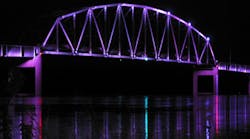Mark Twain once waxed poetic about the beautiful sunsets he'd witnessed in Muscatine, Iowa, but it's what happens after dark that has the town buzzing these days. Come nightfall, the city's Norbert F. Beckey Bridge, which stretches 1,500 feet from Iowa to Illinois across the Mississippi River, is awash in a rainbow of colors emanating from 43 light-emitting diode (LED) fixtures.
The idea to light the bridge using LEDs came about in 2005, when members of Leadership Muscatine — a program co-sponsored by Muscatine Community College and the Greater Muscatine Chamber of Commerce and Industry — decided to combine art with technology and infrastructure. Thanks in part to a $100,000 grant from the Iowa Department of Transportation (DOT) and a gift of $250,000 from Muscatine-based Musco Lighting, the team's vision become a reality on May 12, 2008.
“From the outset, this was a community-based venture,” says Dave Moritz, the Beckey Bridge lighting designer who serves as a project manager for Stanley Consultants, a provider of engineering, environmental, and construction services also headquartered in Muscatine. “In addition to monetary and materials gifts from various contributors, Stanley Consultants allowed me to donate my design time to the project.”
What is thought to be the first bridge to cross the Mississippi in the Midwest to be illuminated by LEDs, the structure's lighting system — which is programmed and controlled by Muscatine Power & Water — features 16.7 million color options. Numerous color patterns can be programmed for holidays, seasons, and special events via a DMX lighting controller. Furthermore, an astronomical time clock allows the lights to automatically operate from dusk to 1 a.m. without human intervention.
“The lights switch colors every 15 to 20 seconds,” notes Moritz. “Because the system is IP addressable, color schemes can be changed at will via a laptop computer.”
Although installation took just four months, the project was not without challenges. According to Moritz, approval had to be obtained not only from the City of Muscatine, but also from the Iowa DOT, the Illinois DOT, and the U.S. Coast Guard.
“As a result of the 2007 Minneapolis bridge collapse, we weren't allowed to drill into the structure at all — not even to install conduit clamps,” he says. “We ended up fabricating stanchions on which to mount the LEDs and ran the conduit through weepholes.”
To ensure driver safety, the LED luminaires, which can rotate 360 degrees and have an estimated 12-year lifespan, had to be aimed in parallel with the truss-style bridge so their light would not affect vehicles traversing the structure at night. Painted the same color green as the bridge, Moritz says the fixtures are nearly invisible during the day. For traffic control override, the system features fiber-optic transmitters and receivers.
“Although the bridge is only illuminated on the side that faces Muscatine, barge operators can request the lights be turned off, if they desire,” explains Moritz. “But from what I've been told, most of them are enjoying the lights as much as the rest of us.”



